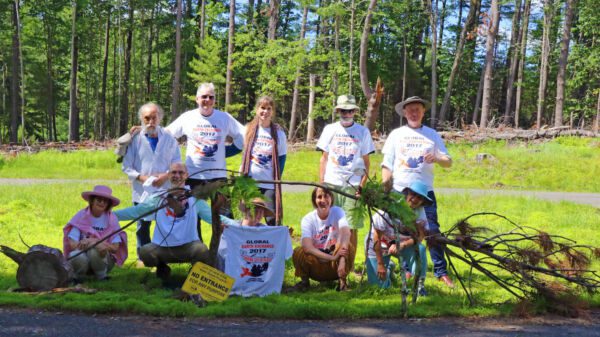Story Info
Story Info

Polly Howells
Ashokan, New York, USA
2017
Type of Wounded Place
Story & Experience
On the afternoon of June 24, 2017, twelve of us set off from the westernmost parking lot of the Ashokan Reservoir to walk a mile to the Monument commemorating J. Waldo Smith, the chief engineer of the Ashokan, whose waters began flowing to all five boroughs of New York City in the autumn of 1917.
The land around the Reservoir is owned and managed by the New York City Department of Environmental Protection. In December 2016 they removed what they considered “hazardous trees” in two straight columns leading up the 100-year old monument. They were 100-foot stately red pines, likely planted when the monument was dedicated to J. Waldo in 1936. The DEP also removed all the pines from a nine-acre lot in the vicinity of the monument. They defend their action by saying the monument needs an upgrade and the trees were likely to fall on it. This is possibly true, but it feels like overkill, and the scene is now one of devastation.
We walked around the monument, reading the inscriptions, and then spent some quiet time in the cut area, where voluptuous feathery ferns have filled in the spaces between the fallen timbers. We created a bird from the detritus, a bird that reminded some of us of a fish and so we dubbed it “fishbird.” We walked back along the reservoir and were graced, overhead, by an eagle, an osprey, many swallows, and a turkey buzzard. We heard them celebrating our ceremony of honor for the land and the waters of the Catskill Mountains, as well as for the many people whose lives were forever changed by the erasure of 11 towns in the Esopus Valley when the reservoir was constructed a century ago. The day was gorgeous, the waters and trees rippled by a cooling breeze, and we were infused with a mixture of sadness and joy.
On the afternoon of June 24, 2017, twelve of us set off from the westernmost parking lot of the Ashokan Reservoir to walk a mile to the Monument commemorating J. Waldo Smith, the chief engineer of the Ashokan, whose waters began flowing to all five boroughs of New York City in the autumn of 1917.
The land around the Reservoir is owned and managed by the New York City Department of Environmental Protection. In December 2016 they removed what they considered “hazardous trees” in two straight columns leading up the 100-year old monument. They were 100-foot stately red pines, likely planted when the monument was dedicated to J. Waldo in 1936. The DEP also removed all the pines from a nine-acre lot in the vicinity of the monument. They defend their action by saying the monument needs an upgrade and the trees were likely to fall on it. This is possibly true, but it feels like overkill, and the scene is now one of devastation.
We walked around the monument, reading the inscriptions, and then spent some quiet time in the cut area, where voluptuous feathery ferns have filled in the spaces between the fallen timbers. We created a bird from the detritus, a bird that reminded some of us of a fish and so we dubbed it “fishbird.” We walked back along the reservoir and were graced, overhead, by an eagle, an osprey, many swallows, and a turkey buzzard. We heard them celebrating our ceremony of honor for the land and the waters of the Catskill Mountains, as well as for the many people whose lives were forever changed by the erasure of 11 towns in the Esopus Valley when the reservoir was constructed a century ago. The day was gorgeous, the waters and trees rippled by a cooling breeze, and we were infused with a mixture of sadness and joy.
Ashokan, New York, USA
RECENT STORIES
For the Gulf Coast
Our beaches are being bombarded almost daily since the end of the first week of the sinking of the Deep Water Horizon with gatherings of people or all stripes: protests, prayer groups, volunteers, rallies for [...]
Remembrance Day for Lost Species in Helsinki 2023
On November 30th, there was first a session organized by the Finnish social and health sector project about eco-anxiety and eco-emotions (www.ymparistoahdistus.fi). This “morning coffee roundtable”, a hybrid event, focused this time on ecological grief [...]
Ashdown Forest
Ashdown Forest is an area of natural beauty in West Sussex, England. It is also one of the very few remaining areas of extensive lowland heath left in Europe. This rare and threatened landscape is [...]



